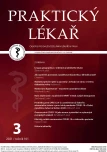Masked hypertension – unjustly neglected area
Authors:
B. Pelechová 1; V. Vejtasová 2; D. Rahelić 3,4,5; J. Bařinka 1; J. Brož 1
Authors‘ workplace:
Interní klinika 2. LF UK a FN Motol, Praha, Přednosta: prof. MUDr. Milan Kvapil, CSc., MBA
1; Kardiologická klinika 2. LF UK a FN Motol, Praha, Přednosta: prof. MUDr. Josef Veselka, CSc.
2; Vuk Vrhovac University Clinic for Diabetes, Endocrinology and Metabolic Diseases, Merkur University Hospital, Zagreb, Croatia, Přednosta: Dr. Dario Rahelić, Ph. D.
3; University of Zagreb, School of Medicine, Zagreb, Croatia
4; Josip Juraj Strossmayer University of Osijek School of Medicine, Osijek, Croatia
5
Published in:
Prakt. Lék. 2021; 101(3): 149-151
Category:
Of different specialties
Overview
Masked hypertension is defined as normal level of blood pressure when measured in doctor’s office and hypertension levels outside of it. Prevalence is usually reported to be around 15%. It is more often detected among patients who had pressure measured in the office at the upper limit of normal blood pressure, or 130–139/80–89 mmHg. More common occurrence is among men, smokers. It is associated with alcohol consumption, stress in workplace, obesity, diabetes or chronic kidney disease. Cardiovascular morbidity and mortality in patients with masked hypertension are almost close to those with persistent hypertension. The recommendations of the European Society of Cardiology and the American College of Cardiology/American Heart Association state that the presence of organ complications associated with hypertension in individuals who have not yet been diagnosed with hypertension as a clear indication for screening of masked hypertension. There haven’t been issued any clear recommendation for masked hypertension, hence therapy is empirical.
Keywords:
masked hypertension – ambulatory blood pressure monitoring – screening
Sources
1. Češka R, Štulc T, Tesař V, Lukáš M. (editoři) Interna. 2. aktualizované vydání. Praha: Triton 2015.
2. Williams B, Mancia G, Spiering W, et al. 2018 ESC/ESH Guidelines for the management of arterial hypertension: The Task Force for the management of arterial hypertension of the European Society of Cardiology and the European Society of Hypertension: The Task Force for the management of arterial hypertension of the European Society of Cardiology and the European Society of Hypertension. J Hypertens 2018; 36(10): 1953–2041.
3. Pickering TG, Davidson K, Gerin W, Schwartz JE. Masked hypertension. Hypertension 2002; 40(6): 795–796.
4. de la Sierra A, Banegas JR, Vinyoles E, et al. Prevalence of masked hypertension in untreated and treated patients with office blood pressure below 130/80 mmHg. Circulation 2018; 137(24): 2651–2653.
5. Brguljan-Hitij J, Thijs L, Li Y, et al. Risk stratification by ambulatory blood pressure monitoring across JNC classes of conventional blood pressure. Am J Hypertens 2014; 27(7): 956–965.
6. Anstey DE, Moise N, Kronish I, Abdalla M. Masked hypertension: whom and how to screen? Curr Hypertens Rep 2019; 21(4): 26.
7. Baguet JP, Lévy P, Barone-Rochette G, et al. Masked hypertension in obstructive sleep apnea syndrome. J Hypertens 2008; 26(5): 885–892.
8. Fagard RH, Cornelissen VA. Incidence of cardiovascular events in white-coat, masked and sustained hypertension versus true normotension: a meta-analysis. J Hypertens 2007; 25(11): 2193–2198.
9. Palla M, Saber H, Konda S, Briasoulis A. Masked hypertension and cardiovascular outcomes: an updated systematic review and meta-analysis. Integr Blood Press Control 2018; 11: 11–24.
10. Hänninen MR, Niiranen TJ, Puukka PJ, et al. Target organ damage and masked hypertension in the general population: the Finn-Home study. J Hypertens 2013; 31(6): 1136–1143.
11. Drawz PE, Alper AB, Anderson AH, et al. Masked hypertension and elevated nighttime blood pressure in CKD: Prevalence and association with target organ damage. Clin J Am Soc Nephrol 2016; 11(4): 642–652.
12. Mancia G, Bombelli M, Facchetti R, et al. Increased long-term risk of new-onset diabetes mellitus in white-coat and masked hypertension. J Hypertens 2009; 27(8): 1672–1678.
13. Whelton PK, Carey RM, Aronow WS, et al. 2017 ACC/AHA/AAPA/ABC/ACPM/AGS/APhA/ASH/ASPC/NMA/PCNA Guideline for the prevention, detection, evaluation, and management of high blood pressure in adults: Executive summary: A Report of the American College of Cardiology/American Heart Association Task force on clinical practice guidelines Hypertension 2018; 71(6): 1269–1324.
14. Widimský J, Filipovský J, Ceral J, a kol. Diagnostické a léčebné postupy u arteriální hypertenze - verze 2017. Doporučení České společnosti pro hypertenzi. Vnitř. Lek. 2018; 64(7–8): 771–796.
Labels
General practitioner for children and adolescents General practitioner for adultsArticle was published in
General Practitioner

2021 Issue 3
- Memantine in Dementia Therapy – Current Findings and Possible Future Applications
- Memantine Eases Daily Life for Patients and Caregivers
- What Effect Can Be Expected from Limosilactobacillus reuteri in Mucositis and Peri-Implantitis?
- Metamizole at a Glance and in Practice – Effective Non-Opioid Analgesic for All Ages
Most read in this issue
- How to (correctly) process and publish case report from clinical practice?
- Our experience with the use of NPWT methods and their availability
- Lingua geographica in the general practitioner’s surgery
- Clinical course of COVID-19 in a high-risk patient
